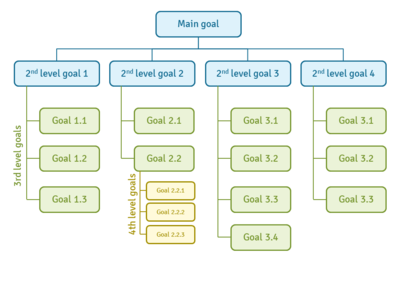Classification of goals and functions: Difference between revisions
Ceopediabot (talk | contribs) m (→Types of functions: Typos, typos fixed: ie. → i.e.) |
m (→Types of goals) |
||
| Line 19: | Line 19: | ||
==Types of goals== | ==Types of goals== | ||
[[File:classification_of_goals_and_functions.png|400px|right|thumb|Fig.1. Classification of goals or functions]] | |||
Goals or [[objectives of the organization]] usually mean a particular state, situational or [[behaviour]] requirements for anticipated action ([[project]], task). Due to the importance of the goals there are: | Goals or [[objectives of the organization]] usually mean a particular state, situational or [[behaviour]] requirements for anticipated action ([[project]], task). Due to the importance of the goals there are: | ||
* main and subordinate goals, | * main and subordinate goals, | ||
| Line 27: | Line 28: | ||
* overall goal and specific objectives - set for specific time horizon and for the whole company, | * overall goal and specific objectives - set for specific time horizon and for the whole company, | ||
* sub-goals - associated with different organizational units at different levels, from strategic to operational level. | * sub-goals - associated with different organizational units at different levels, from strategic to operational level. | ||
==Types of functions== | ==Types of functions== | ||
Revision as of 15:23, 3 September 2020
| Classification of goals and functions |
|---|
| See also |
Classification of goals and function makes distinction between two category of terms, which are often used interchangeably by managers. Goal refers to formally established and expected state of future, which results from decisions of management and actions of employees. Goals often corresponds to needs of company owners, managers and broad socio-economic environment in which the company operates. Function on the other hand specifies concrete action of people in organization, which is undertaken in order to achieve some formal or informal goals.
Types of goals
Goals or objectives of the organization usually mean a particular state, situational or behaviour requirements for anticipated action (project, task). Due to the importance of the goals there are:
- main and subordinate goals,
- operational, tactical and strategic goals.
Due to the horizontal and vertical fragmentation of the system there are:
- one level goals - for one level of organizational structure,
- overall goal and specific objectives - set for specific time horizon and for the whole company,
- sub-goals - associated with different organizational units at different levels, from strategic to operational level.
Types of functions
In organization function should be distinguished from other meaning i.e. function of an technological object (for example: function of car is transportation of people or cargo).
In this context function is concrete action undertaken to achieve previously set goal, also function is regarded as a structural property of organizational system. Functions are all activities that involve using various resources (material, financial, etc.), in order to achieve established goal.
Correctness of the classification of goals and functions requires evaluation of:
- completeness - striving to make sure that there are no missing goals and functions,
- separation - avoiding situation of duplication of goals and functions,
- complementarity and consistency of classification - to avoid different terms having the same meaning.
References
- Lind, M. (1994). Modeling goals and functions of complex industrial plants. Applied Artificial Intelligence an International Journal, 8(2), 259-283.
- Locke, E. A., & Latham, G. P. (2002). Building a practically useful theory of goal setting and task motivation: A 35-year odyssey. American psychologist, 57(9), 705.
- Locke, E. A., Shaw, K. N., Saari, L. M., & Latham, G. P. (1981). Goal setting and task performance: 1969–1980. Psychological bulletin, 90(1), 125.
- Perrow, C. (1961). The analysis of goals in complex organizations. American sociological review, 854-866.
- Turner, J. R., & Cochrane, R. A. (1993). Goals-and-methods matrix: coping with projects with ill defined goals and/or methods of achieving them. International Journal of project management, 11(2), 93-102.
